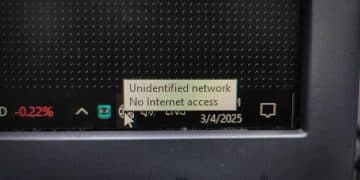FCC Spectrum Auction 2025: Impact on TV Viewers in US

The FCC’s approval of a new spectrum auction for TV broadcasters in 2025 is poised to reshape the television landscape in the US, potentially impacting broadcast quality, channel availability, and the viewing experience for millions of Americans.
The upcoming FCC Approves New Spectrum Auction for TV Broadcasters: What It Means for Viewers in 2025 promises significant changes in how Americans receive their television broadcasts. Understanding these changes is crucial for every viewer.
Understanding the FCC Spectrum Auction
The FCC spectrum auction is a process by which the Federal Communications Commission (FCC) sells licenses to use specific radio frequencies to broadcasters and other entities. These frequencies are portions of the electromagnetic spectrum used for communication. Let’s explore what this means.
Auctions are conducted to allocate spectrum efficiently, ensuring that it is used where it provides the greatest benefit to the public. In the context of TV broadcasting, this has implications for channel availability, signal strength, and the overall quality of over-the-air broadcasts.

Why Are Spectrum Auctions Necessary?
Spectrum is a finite resource, and demand for it is constantly increasing. Auctions help to determine the most valuable uses for different parts of the spectrum and ensure that licenses are awarded to those who will use them most efficiently.
How Does the Auction Process Work?
The FCC conducts auctions using a bidding system where eligible entities compete to win licenses. Bidders must meet certain qualifications, and the auction rules are designed to promote competition and prevent collusion.
- Bidders apply and are vetted for eligibility.
- Bidding rounds take place, with participants submitting bids for specific licenses.
- Winning bidders are responsible for paying for their licenses and complying with FCC regulations.
- The revenue generated from auctions is often used to fund government programs.
Understanding the mechanics of the FCC spectrum auction is essential to appreciating its potential effects on the TV broadcasting industry and the viewing public.
The 2025 Auction: Goals and Objectives
The upcoming 2025 spectrum auction has specific goals and objectives aimed at modernizing the broadcasting landscape and addressing emerging needs in the communication sector. Let’s dive into the details.
The FCC hopes to accomplish several key objectives, including freeing up spectrum, supporting new technologies, and enhancing the overall quality of broadcast services.
Reallocating Spectrum for New Technologies
One of the primary goals of the 2025 auction is to reallocate parts of the spectrum to accommodate new technologies, such as 5G and other advanced communication systems. This involves repurposing existing TV broadcast frequencies.
Improving Broadcast Efficiency
The auction also seeks to improve the efficiency of broadcast operations. This can be achieved by incentivizing broadcasters to adopt more spectrum-efficient technologies and practices.

- Encourage broadcasters to transition to ATSC 3.0 (NextGen TV) standards.
- Consolidate broadcasting operations into fewer channels.
- Promote innovation and the development of new broadcast services.
Achieving these goals will require collaboration between the FCC, broadcasters, and technology providers. The outcome of the auction will shape the future of TV broadcasting in the US for years to come.
Impact on TV Broadcasters
The 2025 spectrum auction is poised to bring about significant changes for TV broadcasters. These changes will impact their operational models, technological investments, and their strategies for engaging with viewers.
Broadcasters face both challenges and opportunities as the auction unfolds. Those who adapt proactively stand to benefit the most.
Potential Challenges for Broadcasters
One of the main challenges for broadcasters is the potential for displacement and the need to find new frequencies. This could require significant investment in new equipment and infrastructure.
Opportunities for Innovation
Despite the challenges, the auction also opens doors for innovation. Broadcasters can leverage the new spectrum to offer enhanced services, such as 4K broadcasting, interactive content, and improved mobile access.
- Investing in ATSC 3.0 technology to improve broadcast quality.
- Exploring new business models, such as datacasting and targeted advertising.
- Collaborating with other broadcasters to share resources and reduce costs.
Broadcasters must carefully evaluate their options and make strategic decisions to navigate the changing landscape effectively. The choices they make will determine their long-term viability in the market.
How Viewers Will Be Affected
The decisions made during the 2025 spectrum auction will directly impact TV viewers across the US. These impacts may range from changes in channel lineup to enhancements in broadcast quality. Let’s examine these potential outcomes.
Viewers should prepare for possible shifts in how they access and experience broadcast television. Awareness is the first step in adapting to these changes.
Changes in Channel Availability
One of the most immediate effects of the auction could be changes in channel availability. Some channels may be moved to different frequencies, while others may cease broadcasting altogether.
Improvements in Broadcast Quality
On the positive side, the auction could lead to improvements in broadcast quality. With the adoption of ATSC 3.0, viewers may experience sharper images, better sound, and more interactive features.
- Rescan their TVs to find newly assigned channels.
- Consider investing in ATSC 3.0-compatible equipment.
- Stay informed about changes in their local broadcast market.
Engaging with these potential changes proactively will help viewers make the most of the updated broadcasting landscape.
Navigating the Transition to ATSC 3.0
ATSC 3.0, also known as NextGen TV, is a new broadcast standard that promises significant upgrades in television technology. Its adoption is closely tied to the outcomes of the spectrum auction. Let’s explore what viewers need to know.
Understanding the benefits and requirements of ATSC 3.0 is essential for viewers who want to take full advantage of the new broadcast opportunities.
Benefits of ATSC 3.0
ATSC 3.0 offers numerous advantages over the current ATSC 1.0 standard. These include higher resolution video, immersive audio, and interactive features.
Requirements for Receiving ATSC 3.0 Signals
To receive ATSC 3.0 signals, viewers need a compatible television or set-top box. These devices are designed to decode the new broadcast standard.
- Look for TVs or set-top boxes labeled as ATSC 3.0 compatible.
- Ensure their antenna is capable of receiving the new signals.
- Update their TV’s firmware to the latest version.
By taking these steps, viewers can ensure they are ready to experience the full potential of NextGen TV and the enhancements brought about by the spectrum auction.
Future of TV Broadcasting in the US
The 2025 spectrum auction and the transition to ATSC 3.0 are significant milestones in the evolution of TV broadcasting in the US. These developments are setting the stage for a future where television is more dynamic, interactive, and personalized.
The integration of these advancements holds the key to the future of how Americans will consume and engage with broadcast television.
Emerging Trends in Broadcasting Technology
Several emerging trends are shaping the future of broadcasting technology. These include the convergence of broadcast and broadband, the rise of streaming services, and the increasing use of data analytics.
The Role of the FCC
The FCC plays a crucial role in shaping the regulatory environment for TV broadcasting. Its decisions will influence the pace of innovation and the availability of broadcast services.
- Promote competition and innovation in the broadcasting industry.
- Protect consumers and ensure access to quality broadcast services.
- Adapt regulations to keep pace with technological advancements.
By embracing these trends and working collaboratively, the FCC and broadcasters can ensure that TV broadcasting remains a relevant and valuable part of the media landscape in the US.
| Key Point | Brief Description |
|---|---|
| 📡 Spectrum Auction | FCC selling licenses for radio frequencies to broadcasters. |
| 📺 ATSC 3.0 | NextGen TV standard offering better quality and features. |
| 📱 Viewers Impact | Potential changes in channel lineup and broadcast quality. |
| 🌐 New Tech | Reallocating spectrum for 5G and advanced technologies. |
Frequently Asked Questions
▼
The FCC spectrum auction is a process where the Federal Communications Commission sells licenses to use specific radio frequencies, helping allocate spectrum efficiently and ensure its best use.
▼
The 2025 auction may lead to changes in channel availability and potentially improvements in broadcast quality, particularly with the adoption of ATSC 3.0 technology.
▼
ATSC 3.0, or NextGen TV, is a new broadcast standard offering higher resolution video, immersive audio, and interactive features, enhancing the overall viewing experience.
▼
To receive ATSC 3.0 signals, you’ll need a compatible television or set-top box designed to decode the new broadcast standard, ensuring you’re ready for NextGen TV.
▼
Spectrum reallocation is essential to accommodate new technologies like 5G, ensure efficient use of finite resources, and support innovation in the communication sector.
Conclusion
As the FCC Approves New Spectrum Auction for TV Broadcasters: What It Means for Viewers in 2025 unfolds, viewers should remain informed and proactive. By understanding the implications of the auction and embracing new technologies like ATSC 3.0, they can navigate the changes and enjoy an enhanced viewing experience. The future of TV broadcasting in the US is dynamic, and staying updated is key.





